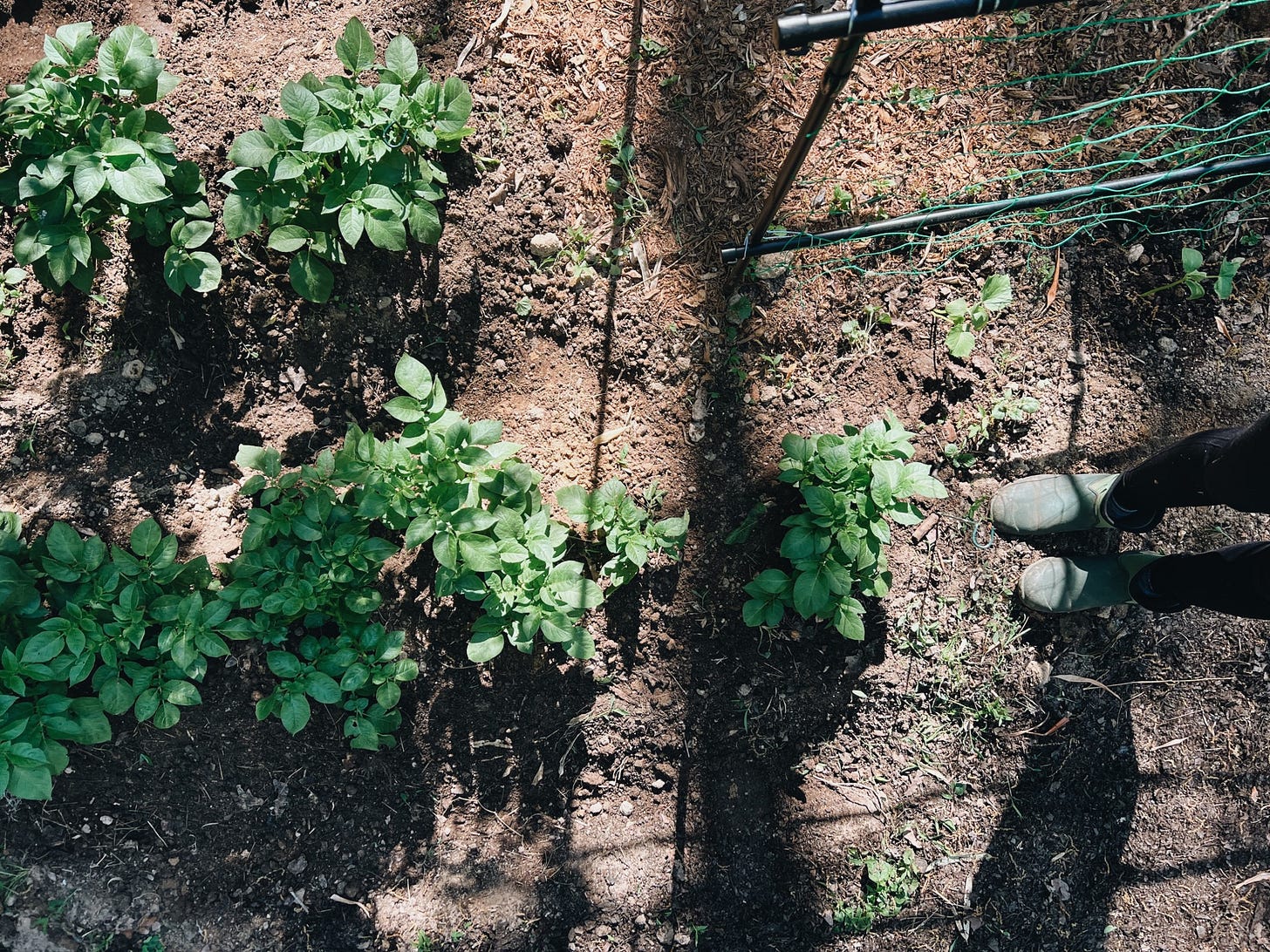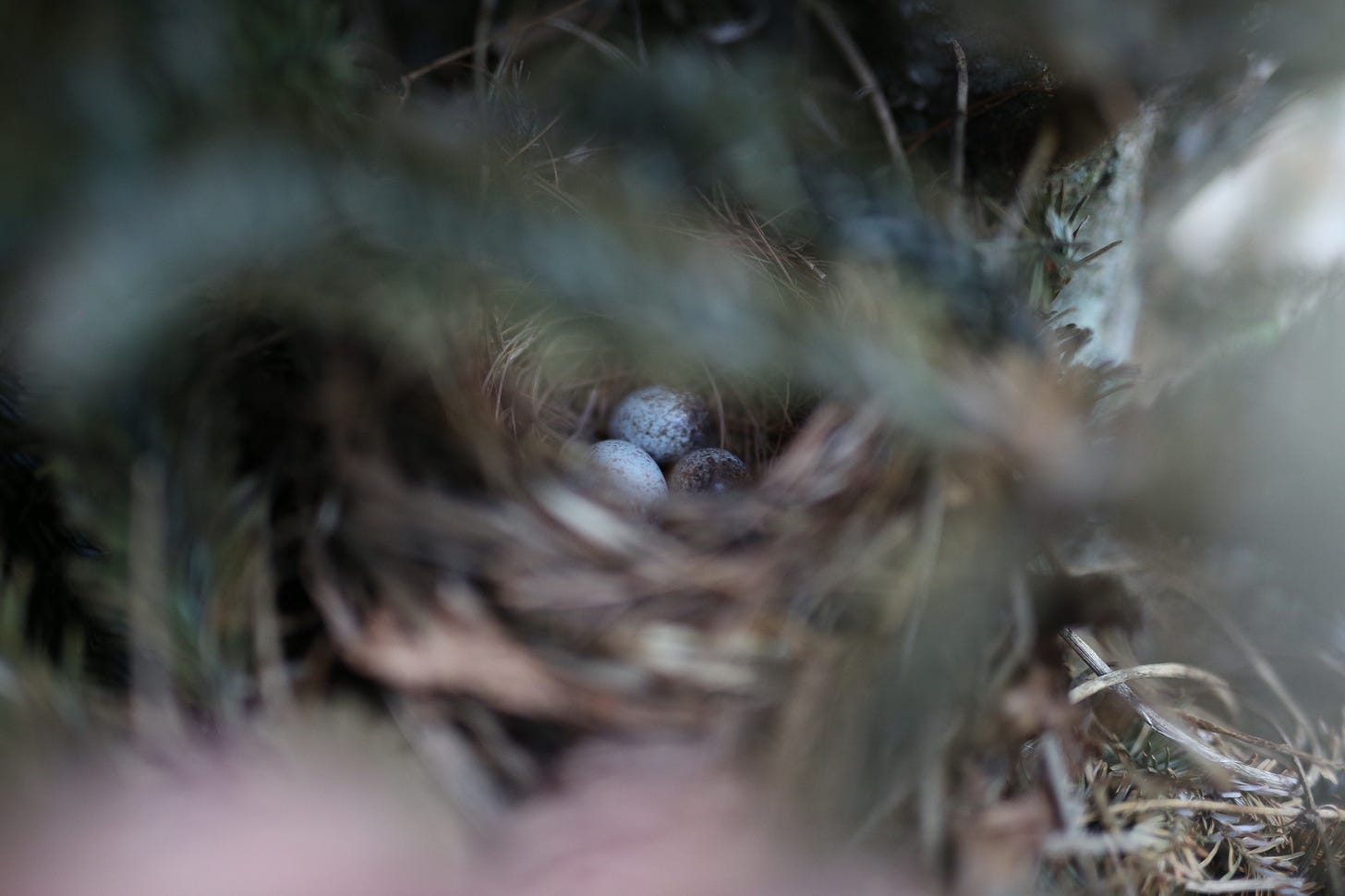🌻 soil 101 class tmrw, sat @ 2pm [free / virtual] 🌻
plus tips for spring gardening, irrigation systems, & fav listens of the week
Happy Friday everyone! You’ve made it to the glorious weekend and I hope you get at least an hour to spend in the garden, practicing thinking about your body and all the wonderful things it can do with you and for you.
Our baby chickadees are due to fledge this weekend, and our Towhee eggs should hatch - both of which I’m really looking forward to, and the cats are strictly Not Allowed Outside This Weekend.
Speaking of cats, the 87 degree day really got to us, and Pixel found so many new luxurious places to escape the heat.
Time is speeding up and my next project is putting in irrigation systems. I’ve always thought these were really expensive, but you can put in about 100 feet of soaker or dripline for $50 — and it’s surprisingly easy. Our front flower bed is south-facing and in full sun, and by mid-summer the hour-long-watering-session is both expensive, tiresome, and not realistic. Dry clay is even more dense than damp clay, so if my perennials stand any chance of expanding year over year, I need to supply them with consistent moisture.
I am using soaker hoses* for intensive planting in raised beds, and rainbird drip lines** for my rows and flower beds, where larger plants are all about a foot apart and a singular emitter releases anywhere between half gallon to a gallon per hour, right at ground level. This is particularly helpful for tomatoes, which are susceptible to fungus and diseases that thrive under warm, damp, leaves.
*I buy the 100ft from Lowes or Home Depot because it comes with the hardware: feeders, t-connectors, male and female connectors, and plugs.
**You can buy drip line with holes at different spacing; every 6”, 12”, 18”, etc or you can just buy a solid hose and custom-punch holes in to fit your exact garden.
DIRT STUFF
There is an entire universe underneath our feet and we rarely think about it. (There isn’t even a dirt or digging emoji?)There are 1 billion microorganisms in a teaspoon of soil. These microorganisms are often the difference between someone who appears to have a green thumb and someone who kills everything. Because we were never taught about the life in the soil, we haven’t known that we‘ve been destroying it at near-irreversible rates. We really don’t know what microorganisms do, or what it means to have or not have them.
Soil science has been the most fascinating learning of my life to date and I hope I pursue it for the rest of my years. Even the ancients who have said “from dust we are created and to dust we will return” hint that we only are as alive as the soil around us is - because we our physical bodies are so deeply connected to it.
The skill of growing food in America was really lost with the last generation - and it was intentional. Unchecked capitalism and the allure of maximizing agricultural profit drove our government officials, private corporations, and financial institutions to drive our generation out of growing and make us believe that to grow food is for those who farm as a career. Family farming by the common citizen was forced to “go big or get out.” and so we all got out.
For centuries, every human has grown food - and our generation has been conned into believing that it’s a difficult expertise and unattainable. We think it’s too complicated and takes special skills. What we don’t know is that our generation also has a challenge no previous generation has had: the destruction of soil fertility, soil structure, and soil biota.
If you don’t know what these things are - that’s okay!
I am teaching a free virtual soil science 101 class tomorrow: Saturday, April 30 from 2-3pm EST. Come join, even if you’re just curious to know a little more than you did yesterday. I will explain the microbiology and nutrients of the soil, how to improve clay or other poor soil, how to test it, what soil to buy/stay away from, and tips for your compost pile. You can stay longer for Q&A from 3-3:30p too.
Arm yourself with knowledge. Understanding soil = understanding food = understanding your health = understanding our future.
I’m not one to quote presidents, but in February 1937, Franklin D Roosevelt wrote to all State Governors in the country, urging them to pay more attention to the agricultural policies we were implementing and pushing for better soil management. He wrote, “The nation that destroys its soil destroys itself.”
EASY TIPS FOR SPRING GARDENING
Here’s a little round-up of some tips that have been top of mind for me lately! I hope they help in your garden endeavors, and if you have a hot tip you’ve just learned, please leave a comment to share with the floricult fam!
Planting + Transplanting:
Soak your babies in their trays/pots before moving them into a larger pot or putting them in ground. Wet roots are more protected than dry roots, and will shield the plant from picking up harmful spores, germs, or just physical damage.
Plant your tomatoes deep! Put 1-2 inches of the stem underground to encourage a larger root system.
When deciding how close to plant, I recommend searching “Square Foot Gardening spacing” or “Intensive Planting spacing” rather than following the label. You can usually plant closer together than the label, and keep more of your soil covered by the plants leaves, creating a living mulch.
Feeding:
If you are planting into an existing bed, put 2-3” of high quality compost down on top. No need to stir it in and disrupt the microbiome of the bed. I love FoxFarm Soil Conditioner and I’m experimenting with Daddy Pete’s Kickin Chickin right now.
Consider using slow release organic fertilizer instead of or in addition to liquid / water soluble. Espoma makes a great one that you can mix into the soil as you transplant, or sprinkle on top. They add microbes and micronutrients in addition to your primary N-P-K.
Deadhead your flowers as soon as they begin to fade. This re-directs energy to the rest of the plant and keeps it from feeding the dying flower/creating seeds instead. This is really helpful especially in early spring to promote fast growth and healthy roots.
Watering:
Practice sticking your finger into the dirt before and after watering. The visible part of soil is very misleading. Sometimes it’s damp immediately under the surface and watering can cause over-watering issues. You also can water but only reach the top 1/4”, leaving the roots dry. In the spring, try to do frequent shallow watering and by June, transition to infrequent, deep watering. I try to keep the top inch moist in early Spring for my seedlings — but once plants are established, it’s better to water deeply less often.
Try to water in the mornings rather than the evenings. Watering in the evenings is not bad - and if your plants are droopy, go ahead and give them a drink - but allowing the plant to dry off in the sun so that the leaves and top layer of roots are not wet and attracting disease or pests.
Houseplant tip! Use lukewarm or slightly warm water. Cool soil inhibits water and nutrient uptake.
Building an Ecosystem that Thrives
Put water in 2-3 places on your property to attract birds, bees, butterflies, wasps and more. This can be bird baths or large pans at ground level. It’s amazing to watch birds hop around eating bugs off my plants! I’ve even been watching wasps carry off my cabbage worms.
Put flowers in your edible garden beds/areas. It’s key to having happy soil and also attracting pollinators. Don’t be afraid to drop a zinnia, marigold, or sunflower smack dab in the middle.
Balance the colors in your flowers: Different colors attract different things so having a mix of whites, yellows, oranges, pinks and purples can do wonders for multiplying the life in your yard.
3 interesting things to listen to this weekend for my podcast lovers (or skeptics):
Averting the Insect Apocalypse with Dave Goulson and Joe Lamp’l
Uncovering Black Garden History with Abra Lee and Joe Lamp’l
Some my favorite throwback writings for the new subscribers:
The famous bean essay aka my proclamation of love to beans
Some help with garden planning and cool vs warm season crops
Our yard before we tore up the driveway & how to understand N-P-K
You can always peruse the 2022 archive here and 2021 archive here
Lastly, thank you to everyone who has been purchasing their plant and herb starts from me this year at Fancy Groceries or just over Instagram DM and coming to pick up in Ardmore. I had no idea how much I would love growing these babies or finding them good homes, and I really hope to keep it up through the year - even supplying your gardens with cool season crops so that we can all keep growing food through the fall and even early winter. Supporting my efforts in this way has really encouraged me to KEEP GOING and of course really helps pay the bills, so I am grateful. :)















